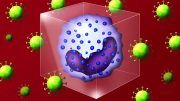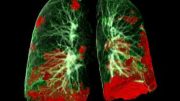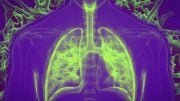
Researchers have potentially identified a treatment for the rare lung disease LAM, found in women of childbearing age. By targeting a newly discovered dysregulated pathway, two existing drugs might effectively treat and possibly cure LAM.
The findings could lead to a cure for LAM.
Researchers from the University of Cincinnati may have identified a potential treatment for lymphangioleiomyomatosis (LAM), a rare lung condition resembling cancer found predominantly in women of reproductive age.
The exact cause of LAM remains a mystery, and no known cure exists. However, new research funded by the National Heart, Lung, and Blood Institute have revealed that two currently available drugs could be promising in treating LAM, potentially paving the way for a cure.
The study was recently published in the journal Science Advances.
“The exact number of women with LAM is unknown but it is estimated that for every 1 million women in the world, three to seven women have LAM,” says Tasnim Olatoke, third-year graduate student in the UC College of Medicine and lead author on the study. “This life-threatening disease is caused by slow infiltration of abnormal cells into the lungs, which form tumors that damage the lungs and lead to difficulty in breathing.”
Olatoke says sirolimus, the only Food and Drug Administration-approved drug and current medication of choice for treating LAM, is not optimally efficient and does not cure LAM. The biggest questions facing scientists studying LAM include where these cells come from and why they have such a strong affinity for the lungs. The greatest challenge to finding a cure for LAM is that its underlying mechanism is not completely understood.
“We identified a novel pathway that is dysregulated in LAM,” Olatoke says. “We found two drugs that target this pathway. We are examining both of those drugs to see how we can use them to reduce the progression of LAM.”
Olatoke says once they confirmed that the pathway was dysregulated, they treated cells from those patients with the drug and discovered that, by treating the cells, they were able to kill those tumor cells. The researchers also tried an animal model where they injected the cells that come from patients into them and by treating them with the drug, they were able to limit the survival of the tumor cells and reduce their progression in the lungs as well as limiting tumor development.
“This is an entirely new direction because it has not been explored at all,” Olatoke says. “We do not know where the cells that enter and destroy the lungs come from, but through our findings, we think that the cells come from the uterus. We think that this pathway is originally dysregulated in the uterus, and the cells move from the uterus to the lungs. Nobody has shown that nobody knows where the cells come from, so this is the first evidence-backed proof in the field showing that maybe the cells come from the uterus.”
Olatoke says one of the more satisfying aspects of this research is working with LAM patients, and notes that June is Worldwide LAM Awareness Month.
“They are the nicest, kindest people ever,” she says. “They are going through so much, but they show empathy, they support our research. This study was partly sponsored by them.
“They are just warm and genuine people who really want a cure. They support our research by taking part in clinical trials and being active. Everything we request for our research, they are always ready to help. It’s a beautiful community,” Olatoke says.
“Another rewarding part, especially with this paper, was working with multiple investigators across different institutions,” she says. “The paper is a brainchild of multiple talented investigators across UC, [Cincinnati Children’s Hospital Medical Center] and Texas Tech — a beautiful testament to how collaboration positively drives science.”
According to Olatoke, the findings provide the first proof-of-concept for the potential therapeutic benefit of targeting the pathway signaling in LAM as well as diseases related to tuberous sclerosis complex, a rare genetic disorder that causes benign tumors and lesions. The possibility of what this research could lead to is what excites her about this study.
“It’s the hope that we can find therapeutic strategies to cure LAM,” Olatoke says. “What inspires me every day to continue doing this research is that hopefully we can find something that can be useful to LAM patients.”
Reference: “Single-cell multiomic analysis identifies a HOX-PBX gene network regulating the survival of lymphangioleiomyomatosis cells” by Tasnim Olatoke, Andrew Wagner, Aristotelis Astrinidis, Erik Y. Zhang, Minzhe Guo, Alan G. Zhang, Ushodaya Mattam, Elizabeth J. Kopras, Nishant Gupta, Eric P. Smith, Magdalena Karbowniczek, Maciej M. Markiewski, Kathryn A. Wikenheiser-Brokamp, Jeffrey A. Whitsett, Francis X. McCormack, Yan Xu and Jane J. Yu, 10 May 2023, Science Advances.
DOI: 10.1126/sciadv.adf8549









To Tasnim Olatoke and all the amazing doc, researchers, scientist, tech ext.
I must first thank you all for your time and services, ur hard work and dedication and determination it is so greatly appreciated and will forever live on to the family’s, feature generation, life’s that u all impacted with all the great studies, medicines and break threw u all works so hard to provide.
I will say I DO AGREE THAT ITS A HUGE Possibility THAT THE CELLS STARTS FROM THE Uterus AND IF AND WHEN IT GET TREATED THEN IT WONT PROGRESS SO QUICKLY ALSO MY OPINION IS THAT MANY OTHER DISEASE CAN BE TREATED IF FINDING THE ROOT TO THE BEGING Problem OR DIAGNOSE THANK YOU AGAIN FOR UR GREAT SERVICE AND FOR THE CURE TO COME FROM UR GREAT Achievements THANK YOU ALSO FOR FIGHTING FOR ME AND MY KIDS BECAUSE THEY ARE DISABLE AND NEED Their MOM AS LONG AS POSSIBLE TO GUIDE AND CARE FOR THEM Thank U ALL GOD BLESD
BLESS